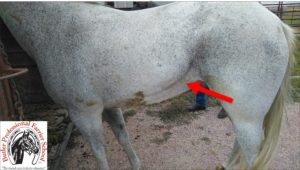Heaves
Some horses can develop a condition known as heaves. Other horses may become “wind-broke.” These ailments have to do with the lungs. Although the subject falls more in the veterinarian’s realm, farriers and all knowledgeable horsemen should be familiar with this condition that horses sometimes get.
Broken wind is a horseman’s term for what many vets and equine professionals now refer to as Equine Chronic Obstructive Pulmonary Disease (COPD) or Equine Chronic Alveolar Emphysema (ECAE). Another common term associated with this disorder is Heaves. It is similar to the condition that some people get from asthma or emphysema. It is a dysfunction of the lungs or respiratory system.
Heaves is most commonly caused by eating dusty or moldy hay. Some horses seem to be more affected by poor quality hay. It might even be said that they have dust allergies. Their lungs fill with dust or other allergens and restrict the breathing. Eventually the lungs become damaged.
Lungs do not resemble large balloons that fill with air. Instead, lungs are sponge-like and made up of many small balloon-like sacs called alveoli. The alveoli are elastic so when oxygen is breathed in, they fill, exchange gases, and when they snap back to their original form carbon dioxide is pushed out. When a horse develops broken wind or heaves, the alveoli lose elasticity and become collapsed. They can take air in but have difficulty pushing it out. Horses must then resort to using their abdominal muscles to push the air out. Breathing sounds labored and is usually accompanied by a persistent cough. Often horses with this condition will develop a groove or “heaves line” across their abdominals.
When trimming or shoeing these horses, the farrier must be patient and work quickly. The horse may pull on the farrier due to spasmodic coughing. Remember that the horse is afflicted with a disease and is not pulling on the farrier on purpose!
In order to avoid your horse getting heaves, simply feed quality hay that is not dusty or moldy. But what about horses that don’t eat moldy hay? Can they develop broken wind too? The short answer is yes. Anything that damages the alveoli and the alveolar sacs can lead a horse to this condition. Horses kept in a stall without adequate ventilation are also at risk for this chronic lung disease.
A horse that is run and never rested, may damage the alveoli in their lungs as well. Inexperienced horsemen may run a horse too hard without stopping the horse for a chance to catch its breath. Some horses are so competitive that if not compelled to stop and rest by the handler, they can damage the respiratory system.
Once a horse gets heaves or broken wind, there is no cure. Symptoms can be alleviated a little bit by soaking hay in water before feeding or keeping the horse in a well ventilated area, but it will not make it go away. The severity of the condition may be reduced when the horse is let out to pasture in the summer. Exercise should be extremely limited for these animals.
Unscrupulous horse traders may mask symptoms with atropine or belladonna drops in order to sell an afflicted animal. Atropine is a bronchodilator that can open the alveoli and prevent a horse from coughing but it does not cure the condition permanently.
As farriers we can help our customers understand that just like many other ailments, prevention is the best cure for this disease. Insuring that your horse is getting quality feed and adequate ventilation where they are stabled is vital to their health. When exercising a horse, it is important to warm up and cool down as well as alternating between slow gaits and fast gaits. Remember to stop and rest if breathing becomes especially labored. Just like people need breaks during exercise, so do horses.
Related Posts
-
So far twenty-six states are said to be suffering under drou...Aug 08, 2012 / 0 comments
-
Happy Thanksgiving! Not only is this a good time to commun...Nov 21, 2018 / 0 comments
-
Recent events have taken a toll on various horse people and ...Aug 30, 2012 / 0 comments
Blog Categories
- Anatomy
- Best Business Practices
- Conformation
- Current Events
- Customer Service
- Draft Horse Shoeing
- Equine Soundness
- Essential Anatomy Kit
- Farrier Careers
- Farrier training
- Foal soundness
- Horse Care
- Horse Foot Care
- Horse Owner Tips
- Horsemanship
- Horseshoeing
- Horseshoeing History
- Iron and Forge Work
- Student Spotlight
- Uncategorized
- Veterinary Care
Blog Archives
Contact Us
Butler Professional Horseshoeing School
495 Table Road
Crawford, NE 69339
(800) 728-3826
jacob@dougbutler.com
Subscribe to Our Blog
Get Our Free e-Book!
If you think you want to become a farrier (or know someone who does), this book can help you make that decision. Horse owners will learn the importance of choosing a qualified farrier and how to select the “right” one.
[ Get the e-Book Now! ]
- Follow:

